More of AMD’s Brazos E-350 with the MSI X370 and Sony VAIO YB
by Jarred Walton & Dustin Sklavos on March 14, 2011 4:50 PM ESTBattery Life: Great for Portability
Our initial E-350 laptop review proved that Brazos is a viable option as an all-day computing device. The two newcomers reinforce this finding, although battery capacities mean the HP dm1z is generally the better option. MSI sent both a 32Wh and 64Wh battery, and we tested with both to show the difference. Contrary to what you might expect, the 64Wh battery actually more than doubles battery life, suggesting the cells may be higher quality than in the 4-cell option.
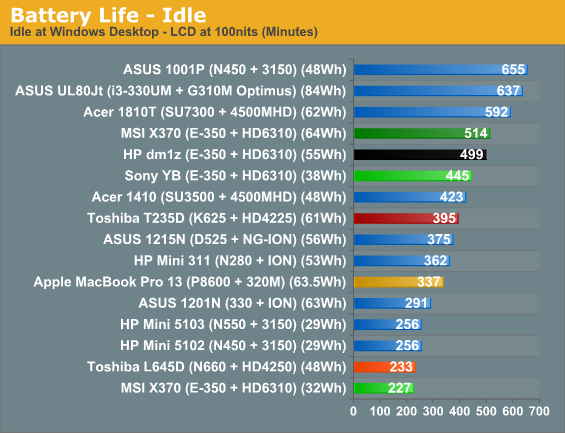
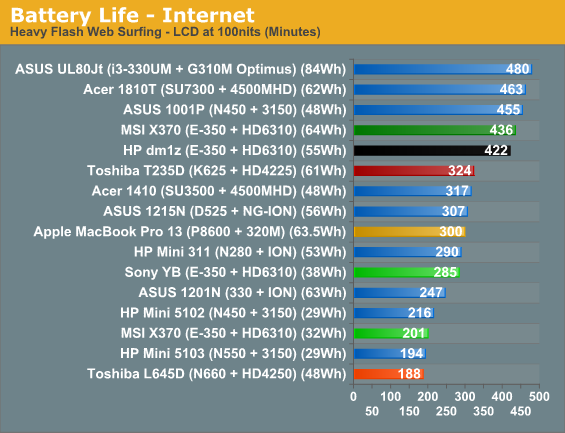
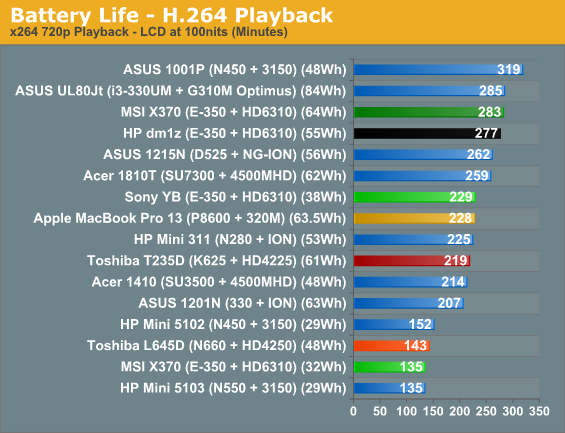
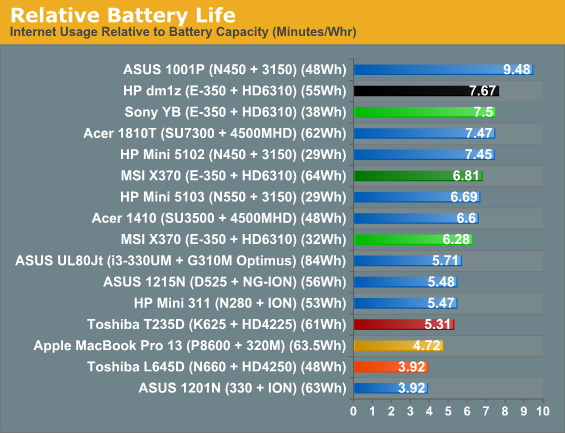
With the 8-cell battery, the X370 lasts just slightly longer than the HP dm1z. The combination of a slightly higher capacity battery with a larger LCD makes it a wash in terms of battery life, but if you have to pay an extra $150 to upgrade to the 8-cell (leaving you with a spare battery that might not see much use) the HP is clearly the better buy. Drop to the 4-cell battery and the HP offers slightly more than twice the battery life.
Sony proved with their EE34 that they know how to tune for better battery life; that particular laptop shipped with a smaller battery and still managed to run longer than other AMD K10.5 systems. So how does the Sony YB fare? It does reasonably well, but the capacity is a concern. There’s again a smaller-than-normal 38Wh battery, which is still better than MSI’s 32Wh default but not up to the 55Wh in the HP. Even with a 45% higher battery capacity, though, HP’s dm1z doesn’t always outlast the YB by a similar margin. The best result is in our Internet test, where it does come out 48% ahead of the YB. Our H.264 playback test has the lead drop to 21%, and in the idle battery life test the margin is only 12%. Sony is clearly ahead in some areas of power management; now all we need is improved Internet battery life and higher capacity batteries (as stock options rather than $250 upgrades).
We ran a few other tests of battery metrics on the MSI X370 to give you an idea of how it fares. Somewhat surprisingly, battery life while gaming (looping 3DMark03 and 3DMark06—the latter used slightly more power) was only slightly worse than the H.264 playback test. We measured 270 minutes in 3D03 and 255 minutes in 3D06 with the 8-cell battery. Cranking the backlight intensity to maximum dropped the Internet battery life result from 201 to 164 minutes; put another way, that works out to an increase power draw of around 2.2W—about a 23% increase for the Internet test, 27% increase at idle, and only a 15% increase in H.264 decoding.
Recharge times for the MSI X370 are pretty long at 141 minutes for the 32Wh and 286 minutes for the 64Wh battery; the charging circuit is the limiting factor here, as even with the laptop off (so it’s not putting a load on the power adapter) we measured power draw at the wall of just 18W. It’s a 40W adapter, and even under full load we never came anywhere near the AC adapter limits: powered on, recharging, and running the SMP Cinebench test we still only registered 39W at the outlet, and accounting for efficiency (we guessed 85%, which is generous) that means the 40W adapter should have at least 7W of headroom remaining. At least that means the recharge times are consistent albeit slow.
So far, a highly optimized Atom netbook like the ASUS 1001P still offers superior battery life, but it comes with a hefty toll in performance. Other Atom netbooks like HP’s 5102 and 5103 don’t do nearly as well, with E-350 actually surpassing them in relative battery life. In general, Brazos offers better than ION battery life, better than ION performance (helped by the CPU), and a similar cost, making it the better choice as a balanced netbook/ultraportable platform.
Temperatures: Bigger Doesn't Mean Cooler
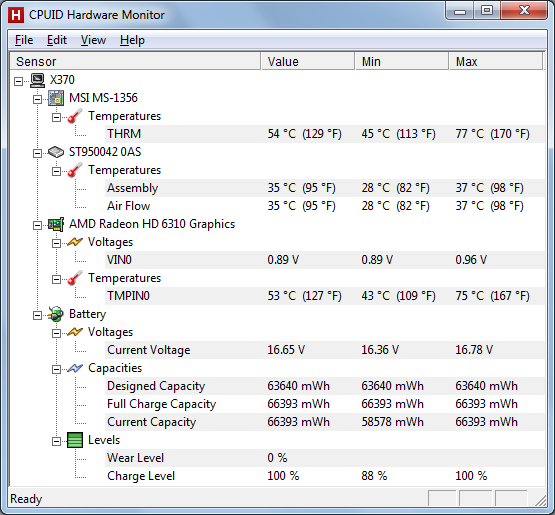
MSI X370 HWMonitor
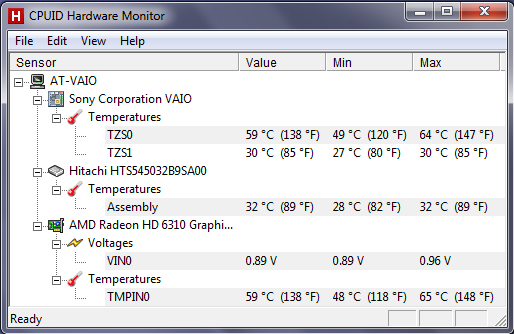
Sony VAIO YB HWMonitor
Interesting to note is that HWMonitor doesn't pick up anything beyond the chassis, HDD, and GPU on the Sony VAIO. On the MSI, we get those same areas along with the usual battery report. Despite having a 13.3"-screen chassis, the X370 actually has higher temperatures on the CPU, GPU, and HDD. The reason for that is pretty simple: the single fan near the front of the MSI chassis doesn't have much in the way of good intake or exhaust vents. Even though it runs hotter, it's also far from being a concern, with surface temperatures rarely breaking 30C.
Noise levels are pretty consistent on the X370 as well, with the fan somewhat audible but not particularly loud. We measured 32dB idle and a slightly higher 35dB under load. Unfortunately, Dustin doesn't have the same testing equipment or environment so he can't reliably measure anything below 40dB right now. Subjectively, the VAIO also runs reasonably quiet and never got annoyingly loud.










43 Comments
View All Comments
Nimiz99 - Monday, March 14, 2011 - link
I like your review of those games for the e-350.I agree, for certain games processor is everything ...but again I think these notebooks are for gaming on the go and shouldn't be a desktop replacement. Im sure eventually we'll get there, right now ppl buying these should know their intended purpose on-the-go/couch consumption.
ET - Wednesday, March 16, 2011 - link
Thanks for mentioning Guild Wars and Champions Online. I've pretty much stopped gaming for the last month or two, but I will hopefully get back to it (once my 2 year old hits 18 :), and running MMO's anywhere is certainly something I'd like to do. In the past I occasionally played City of Heroes on a 1.2GHz Pentium M with GMA 500 graphics. Not much fun, but still worked okay for door missions. So an E-350 will certainly be an upgrade, and 20 FPS in Champions Online sounds decent enough.ash9 - Monday, March 14, 2011 - link
Seems a SSD drive can add .5 to 1 hour worth of added battery life - couple that with tuned applications could mean renewed life for X86 (graphics /science)- comparing Fusion with any of the CPU offerings, including ARM - one has to realize that the Fusion platform's computing power per wattage/ battery life (mobile) has got to beat all others hands down - lest we forget price. Try and run a Monte Carlo simulation on an Ipad2.asH
DMisner - Monday, March 14, 2011 - link
Please don't forget to review the Thinkpad X120e!mgl888 - Monday, March 14, 2011 - link
+1 to this!Thanks for the gaming benchmarks.
Tasslehoff Burrfoot - Tuesday, March 15, 2011 - link
+1blacklist - Monday, March 14, 2011 - link
until now i was expecting all the brazos netbooks to be release in order to buy the best one. i thought the x370 would be the chosen one but... well, the facts are the facts and clearly it is a mediocre ultraportable if that $700+ msrp is real. now i'm waiting for the lenovo s205 to be reviewed (please, don't forget to review it) and find if it's as good as it looks. if not, then i will have to settle for the dm1z.deputc26 - Monday, March 14, 2011 - link
"Contrary to what you might expect, the 64Wh battery actually more than doubles battery life, suggesting the cells may be higher quality than in the 4-cell option." I doubt that the cells are different.One characteristic of Li-Co batteries (and pretty much every other chemistry) is that energy density changes with C rate. Which means that doubling a cell's size will more than double capacity given a static load.
tipoo - Tuesday, March 15, 2011 - link
This is true. The slower you deplete a batteries energy, the more energy you will draw out of it in total.PMing - Tuesday, March 15, 2011 - link
I bought this little beauty last week, and have a rather mixed experience with it. The battery should have been better, Sony only provide a measle less than 5 hours of usage, while the new AMD Zacate should be able to perform longer with bigger battery. The keyboard is not exactly spacious enough visually, but it's better once I got used to it. Yet even first generation of Dell Mini 10 outperforms Vaio YB in terms of keyboard ergonomics.The AMD E350 beats Intel Atom to the bottom, especially in terms of video performance. I don't play games, so I'm not sure how it will handle them.
In my region I only got a basic Windows 7 Starter 32-bit, 2 GB memory and 320GB HDD, that is for a steep USD 550. But I guess that is the price you pay if you need a VAIO logo stamped on the lid of your laptop.